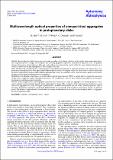Files in this item
Multiwavelength optical properties of compact dust aggregates in protoplanetary disks
Item metadata
| dc.contributor.author | Min, M. | |
| dc.contributor.author | Rab, Ch | |
| dc.contributor.author | Woitke, Peter | |
| dc.contributor.author | Dominik, C. | |
| dc.contributor.author | Ménard, F. | |
| dc.date.accessioned | 2016-02-08T15:40:07Z | |
| dc.date.available | 2016-02-08T15:40:07Z | |
| dc.date.issued | 2016-01 | |
| dc.identifier.citation | Min , M , Rab , C , Woitke , P , Dominik , C & Ménard , F 2016 , ' Multiwavelength optical properties of compact dust aggregates in protoplanetary disks ' , Astronomy & Astrophysics , vol. 585 , A13 . https://doi.org/10.1051/0004-6361/201526048 | en |
| dc.identifier.issn | 0004-6361 | |
| dc.identifier.other | PURE: 240870797 | |
| dc.identifier.other | PURE UUID: f8b0a322-a405-4f9e-abf3-d65dd425caf0 | |
| dc.identifier.other | ArXiv: http://arxiv.org/abs/1510.05426v1 | |
| dc.identifier.other | Scopus: 84949818837 | |
| dc.identifier.other | WOS: 000369710300020 | |
| dc.identifier.uri | https://hdl.handle.net/10023/8180 | |
| dc.description | We gratefully acknowledge funding from the EU FP7-2011 under Grant Agreement No. 284405. Ch.R. acknowledges funding by the Austrian Science Fund (FWF) under project number P24790. | en |
| dc.description.abstract | Context. In protoplanetary disks micron-size dust grains coagulate to form larger structures with complex shapes and compositions. The coagulation process changes the absorption and scattering properties of particles in the disk in significant ways. To properly interpret observations of protoplanetary disks and to place these observations in the context of the first steps of planet formation, it is crucial to understand the optical properties of these complex structures. Aims. We derive the optical properties of dust aggregates using detailed computations of aggregate structures and compare these computationally demanding results with approximate methods that are cheaper to compute in practice. In this way we wish to understand the merits and problems of approximate methods and define the context in which they can or cannot be used to analyze observations of objects where significant grain growth is taking place. Methods. For the detailed computations we used the discrete dipole approximation (DDA), a method able to compute the interaction of light with a complexly shaped, inhomogeneous particle. We compared the results to those obtained using spherical and irregular, homogeneous and inhomogeneous particles. Results. While no approximate method properly reproduces all characteristics of large dust aggregates, the thermal properties of dust can be analyzed using irregularly shaped, porous, inhomogeneous grains. The asymmetry of the scattering phase function is a good indicator of aggregate size, while the degree of polarization is probably determined by the size of the constituent particles. Optical properties derived from aggregates significantly differ from the most frequently used standard (“astronomical silicate” in spherical grains). We outline a computationally fast and relatively accurate method that can be used for a multiwavelength analysis of aggregate dust in protoplanetary disks. | |
| dc.format.extent | 10 | |
| dc.language.iso | eng | |
| dc.relation.ispartof | Astronomy & Astrophysics | en |
| dc.rights | © ESO, 2015. This work is made available online in accordance with the publisher’s policies. This is the final published version of the work, which was originally published at http://dx.doi.org/10.1051/0004-6361/201526048. Reproduced with permission from Astronomy & Astrophysics, © ESO | en |
| dc.subject | Scattering | en |
| dc.subject | Protoplanetary disks | en |
| dc.subject | Opacity | en |
| dc.subject | QB Astronomy | en |
| dc.subject | QC Physics | en |
| dc.subject | NDAS | en |
| dc.subject | BDC | en |
| dc.subject.lcc | QB | en |
| dc.subject.lcc | QC | en |
| dc.title | Multiwavelength optical properties of compact dust aggregates in protoplanetary disks | en |
| dc.type | Journal article | en |
| dc.contributor.sponsor | European Commission | en |
| dc.description.version | Publisher PDF | en |
| dc.contributor.institution | University of St Andrews. School of Physics and Astronomy | en |
| dc.identifier.doi | https://doi.org/10.1051/0004-6361/201526048 | |
| dc.description.status | Peer reviewed | en |
| dc.identifier.grantnumber | 284405 | en |
This item appears in the following Collection(s)
Items in the St Andrews Research Repository are protected by copyright, with all rights reserved, unless otherwise indicated.

